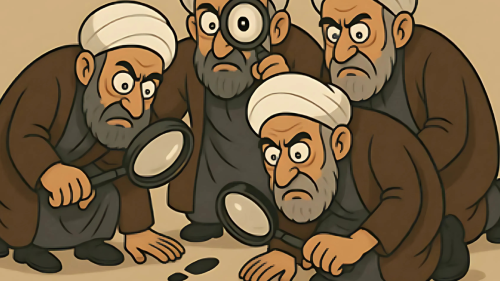Anyone who thinks that the recent protests in 100 cities throughout Iran were about gas prices did not pay attention to what the protesters were saying. The immediate spark that led to the Arab Spring was the 2010 self-immolation of a Tunisian fruit vendor, but the Arab Spring revolution was not about Tunisian citizens’ ability to obtain permits to sell fruit. Likewise, this unrest in Iran was not about the price of gas. Iranian protesters (and rioters) chanting “No to Gaza, no to Lebanon!” “Leave Syria and think of us,” and even “Death to Palestine!” indicates that something much larger than the price of gas drove their outrage.
Forty years after the Islamic Revolution, substantial numbers of Iranians are finally rejecting the priorities of their masters.
Substantial numbers of Iranians are rejecting the priorities of their masters. |
When Ayatollah Ruhollah Khomeini consolidated power in Iran for himself in 1979, he risked being accused of a sin that Islamists of all stripes object to in any non-Sharia government — “making partners with Allah,” something specifically prohibited by the Koran (see 3:64, 12:40 and 42:41, for example). This accusation is especially relevant to democracies. As Abu al-Ali al-Mawdudi, founder of the Jamaat-e-Islami, one of the first Islamist organizations, put it: “Democracy is the deification of man.” Or, as current al Qaeda leader Ayman al-Zawahiri put it: “Democracies raise up gods, establish masters and assign partners to Allah Most High.”
So Khomeini established the velayat-e-faqih (governance of the jurist), which allowed him to pretend that Iran was controlled by divine, rather than human, laws. The premise is that Khomeini’s hand-picked jurors (the mullahs), under the watchful eye of rahbar mo’azzam (Supreme Leader) Khomeini, were simply guiding the country until the 12th imam comes out of hiding to usher in the end of times. In the meantime, to placate the people’s clamoring for freedom, Khomeini established a parliament and president. There would be elections and the guise of competition, but no one would be permitted to run for office without approval from the mullahs. This arrangement created the illusion of democracy while maintaining clerical control.
Iranian democracy is like a landscape painted onto a concrete wall in a zoo. |
Iranian democracy is like a landscape painted onto a concrete wall in a zoo. Artists skilled in trompe l’oeil mimic a jungle landscape on the walls of the lion cage, or a polar landscape for a penguin enclosure, with the aim of calming the beasts through a feeling of openness and freedom. But any lion who charges into the concrete jungle or any penguin that leaps into the nearby “ocean” quickly learns the cruel lesson of his captivity. The Iranian people seem to have realized that they are not free and that their version of democracy is an illusion.
The first indications of their dissatisfaction with the theocracy for which they traded the shah came in the summer of 1999 when university students protested for days, demanding better conditions and greater freedoms. After 9/11 video of spontaneous demonstrations against al Qaeda and terrorism emerged, people with candles and handmade American flags shouted “Down with terrorists!” in cities across Iran. Eventually those demonstrations subsided, only to be followed by the so-called “soccer protests” of 2003 where people used the excuse of their team’s loss or victory in assemblies that quickly turned into anti-regime demonstrations.
With the Green Movement of 2009, the Iranian people turned their attention to the façade of Iranian democracy for the first time. |
But it was not until the Green Movement of 2009 that the Iranian people turned their attention to the façade of Iranian democracy. Public demonstrations erupted when former Prime Minister Mir-Hossein Mousavi did not win the presidential election and the mullahs made sure that Mahmoud Ahmadinejad emerged victorious. Mousavi, perhaps a genuine reformer, had slipped through the mullah’s selection process. Today he lives under house arrest. Since President Obama spent 2009 courting the mullahs for his 2015 nuclear deal, he not only looked the other way but ordered the CIA to sever contacts with the dissidents supporting and controlling the nascent revolution.
Things are different now. During the height of the recent protests, Secretary of State Mike Pompeo tweeted: “After 40 years of tyranny, the proud Iranian people are not staying silent about their government’s abuses. We will not stay silent either. I have a message for the people of Iran: The United States hears you. The United States supports you. The United States is with you.”
In 2009, protesters chanted, “Where is my vote?” and “Give us our votes back.” Now there are reports of people shouting, “We don’t want the ayatollahs!” and “Death to the dictator!” and of people pulling down anti-American banners and billboards. Rioters have burned government buildings, banks and police stations. November 2019 in Iran looked like the revolutionary zeal that brought down Mohammad Reza Pahlavi’s reign over 40 years ago — except now the anger is directed at those responsible for taking down the shah. In fact, some protesters reportedly shouted: “Oh, Shah of Iran, come back to Iran.”
Iranian President Hassan Rouhani may have pronounced the protests over and his regime victorious, but he shouldn’t rest too easily. Even President Trump‘s critics concede that his maximum-pressure sanctions are causing serious pain in Iran, and many believe the regime is in the greatest danger of falling since its inception.
Every day that people openly defy the mullahs in the streets of Iran makes it harder for the clerics to maintain control. If the anti-regime protests continue throughout the winter, can a “Persian Spring” be far behind?
A.J. Caschetta is a Ginsberg-Ingerman fellow at the Middle East Forum and a principal lecturer at the Rochester Institute of Technology.









